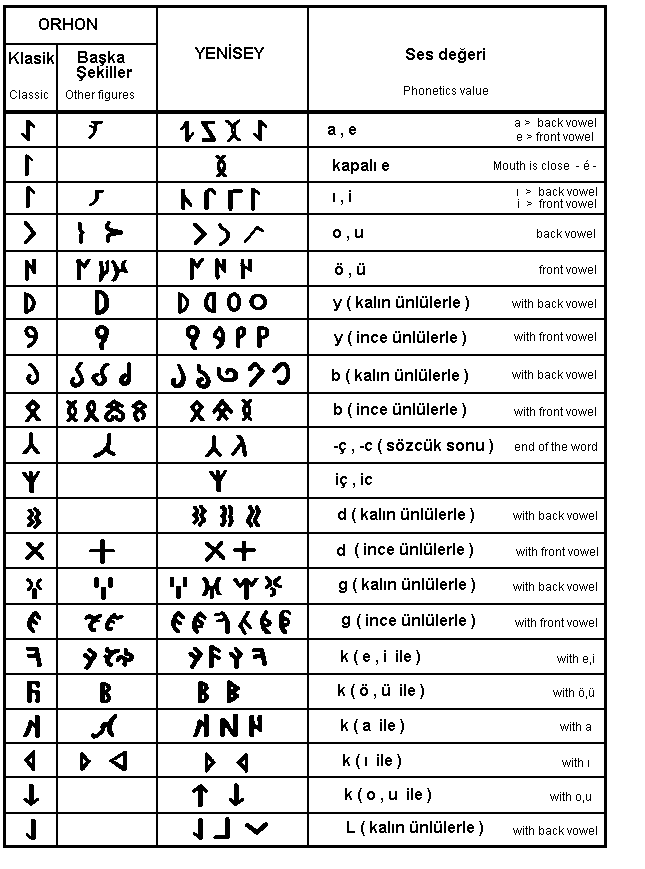Links
http://www.turcoman.btinternet.co.uk/turcoman-contents1.htm
www.Turcoman.btinternet.co.uk
Turgay Kurum January 1994 Address Yeni Lara Yolu, Doktorlar Sitesi No:10
Guzeloba ANTALYA / TURKIYE Tel: 90 - 242 - 349 51 41 Fax: 90 - 242 - 349 51 37
E-Mail : turgay@antalyaonline.net
Introduction
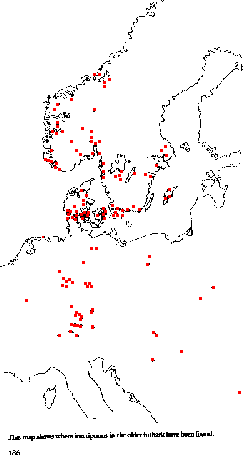
The oldest runic inscriptions group known as "Primitive Futhark", is found inscribed on a rock in Kylver farm in Stanga on Gotland Island, Sweden, the oldest relic in Sweden dating back to the fifth centuryAD, and on two other stone monuments, the Möjbro stone in Uppland, and the Istaby stone in Blekinge.
The Futhark alphabet on the stones in Sweden are:
1. The oldest runic inscriptions. (24-rune Futhark alphabet is reproduced in Rün and Rünik in Big Larousse Encyclopedia, volume 19. Since the 13th character there is wrong, T. Kurum in his article shows its correct form.)
2. Runic inscriptions from the Viking Age. (16-rune Futhark)
In more than 70 locations in the north and northwestern Europe there are numerous stones inscribed with the same alphabet belonging to the same period of history.
The 16-rune Futhark belong to a later period called the Viking Age which started at about 800 AD. During the interim period, the 24 - characters of the Primitive Norse runes became simplified and reduced to 16-rune series.
It is an exciting fact that the Primitive Norse runes can be read by the technoque of reading ancient Türkish scripts.
The ancient Türkish script used in Central Asia and the Primitive Norse futhark in Europe, and other scripts, have all stemmed from a common origin in a very remote past. Then, the Turkish, Germanic, and other tribes have independently relied on this common legacy of writing for writing in their own tongues.
Norse Primitive Futhark rune-row is recorded on a stone, used as a side-slab in a sarcophagus, and found in Kylver farm in Gotland. Since the characters from the 1st to the 6th spell out futhark, this word is used to denote the runic script. However, some characters are cut slightly different on the stone than what is shown within the text

Kylver stone
The stone from Kylver farm in Stanga (Gotland).
Photo from Prof. Sven B.F. Jansson "Runes in Sweden".
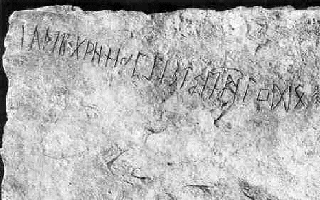
Publication
Jansson, Prof. Sven B.F., Runes in Sweden; translated by Peter Foote, Gidlunds, Varnamo, Sweden 1987. (English edition of Runinskrifter i Sverige, AWE/Gebers 1963).
Readings
Turgay Kurum, Mystery Of The Futhark Alphabet, http://www.turcoman.btinternet.co.uk/turcoman-contents1.htm
Transcription of the inscription and comparison with Orkhon Göktürk equivalent:

Transliteration
gü tü s o k up o d y go n si ka öt a ç nç ok ök id y n i si ke l bi
Transliteration right-to left:
bilke is inydi ök oknça öt akisn goydo pu kosütüg
Dictionary
bilke - wise man, sage; one of wisdom
is - light; light of wisdom, knowledge
inydi - arrived / descended (from the sky)
ök - himself, his own self
oknça - with the (pointed) tip
öt - to speak (as the birds chirp)
aksin - through his mouth (the words he uttered)
goydo - he put (by carving); he carved
pu - this
kosütüg - column; erected slab of stone
Translation from ancient Türkish to today's English:
The light of wisdom arrived/descended, he himself carved onto this erect stone, with ( the pointed tip of ) his arrow/dagger, the words he uttered/spoke through his own mouth.
Möjbro stone
Under inscription is a carving of a rider on a horse, holding a round shield in his left hand while brandishing a weapon in his right. Two dogs run beside the horse.
The Möjbro stone from Uppland, which is a memorial
monument.
Photo from Prof. Sven B.F. Jansson "Runes in Sweden".
Sketch from
http://www.antalyaonline.net/futhark/FUTHP4T.HTM
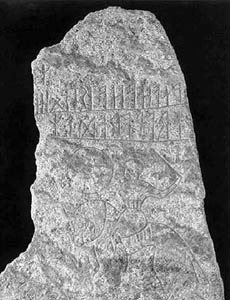
Publication
Jansson, Prof. Sven B.F., Runes in Sweden; translated by Peter Foote, Gidlunds, Varnamo, Sweden 1987. (English edition of Runinskrifter i Sverige, AWE/Gebers 1963).
Readings
Turgay Kurum, Mystery Of The Futhark Alphabet, http://www.turcoman.btinternet.co.uk/turcoman-contents1.htm
Transcription of the inscription and comparison with Orkhon Göktürk equivalent:

Transliteration
ic k ni s de ke p ü s kö g kö g ke ni ki ic k ke l ke op ki y ke op g
Transliteration right-to left:
gopek yik op ke kelkic ikin ekgök göksüpek desinkic
Dictionary
gopek - dog
yik - well
op ke - to attack; to charge
kelkic - undertake (or) achieve
ikin - both; both of them
ekgök - mother-sky: a sacred sky-spirit; mother nature (or) goddess of sky;
göksüpek - bold; brave (or) courageous
desinkiç - to say, to state; to acknowledge
Translation from ancient Türkish to today's English:
(May both of) the dog(s) charge well; so that the sacred sky-spirit acknowledges their boldness..
Istaby stone
Istaby stone from Blekinge was carved in a transitional period between the Primitive Norse period and Viking Age.
Istaby stone from Blekinge.
Photo from Prof. Sven B.F. Jansson "Runes in Sweden".
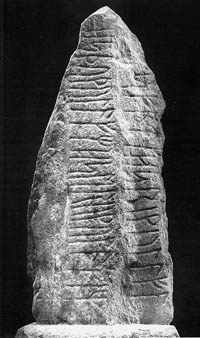
Publication
Jansson, Prof. Sven B.F., Runes in Sweden; translated by Peter Foote, Gidlunds, Varnamo, Sweden 1987. (English edition of Runinskrifter i Sverige, AWE/Gebers 1963).
Readings
Turgay Kurum, Mystery Of The Futhark Alphabet, http://www.turcoman.btinternet.co.uk/turcoman-contents1.htm
Transcription of the inscription
Not given
Comparison with Orkhon Göktürk equivalent:
Not given
Transliteration
g r s o t ya t i ki g iç go r id up t ya t i ki g sü iç r gü k ko iç gu r up s ya t i ki g kö
Transliteration right-to left:
ök gikit yaspurgu içok güriç sü gikit yatpudir goiç gikit yatsorg
Dictionary
ök - he, his own self
gikit - brave
yaspurgu - lived
içok - much, many
güriç - forte; force(ful); hard(ship)
sü - army, soldiers
yatpudir - committed not
goiç - flight; migration
yatsorg - lies (herein)
Translation from ancient Türkish to today's English:
he (who was) brave (and) lived through many hardships (of) army, committed not flight (or did not desert his post of duty) lies herein...
BIBLIOGRAPHY
More specific information on the Göktürks and their inscription is accessible in Prof. Ergin's concise book.
Jansson, Prof. Sven B.F., Runes in Sweden; translated by Peter Foote, Gidlunds, Varnamo, Sweden 1987. (English edition of Runinskrifter i Sverige, AWE/Gebers 1963).
The photographs of the stone monuments in Sweden (Appendix A) are provided in Prof. Jansson's book. The inscriptions are clearly legible in these photographs.
Büyük Larousse, Interpress-Milliyet, Istanbul,Türkiye 1993; The Turkish edition of Grand Dictionnaire Encyclopedique, Larousse (GDEL), Paris, France.
The Göktürk alphabet used in this article is taken from the encyclopedia's entry Göktürkçe on page 4678, vol. 9. (Appendices B and C).
http://www.antalyaonline.net/futhark/FUTHA2T.HTM Attachment 2
